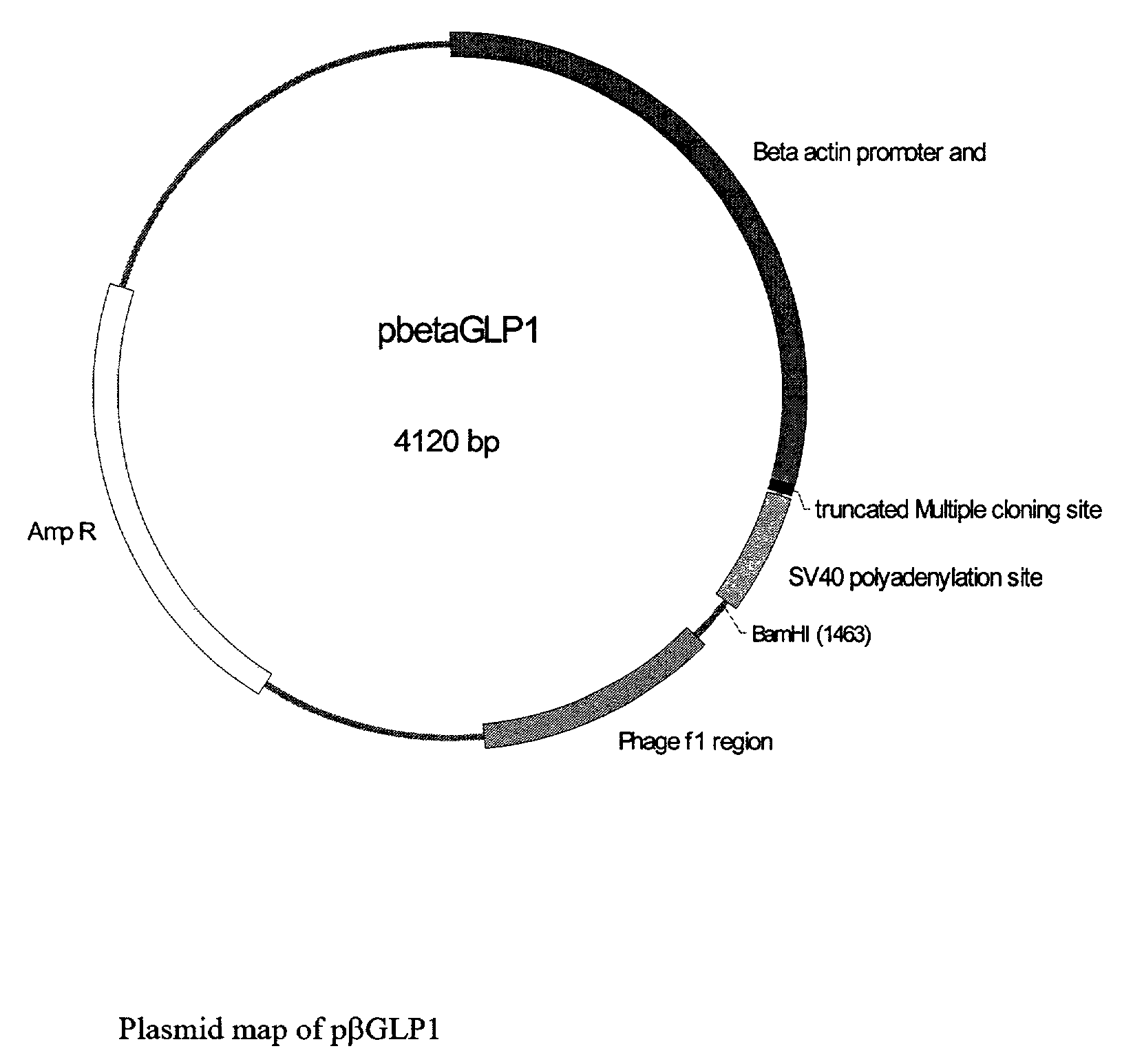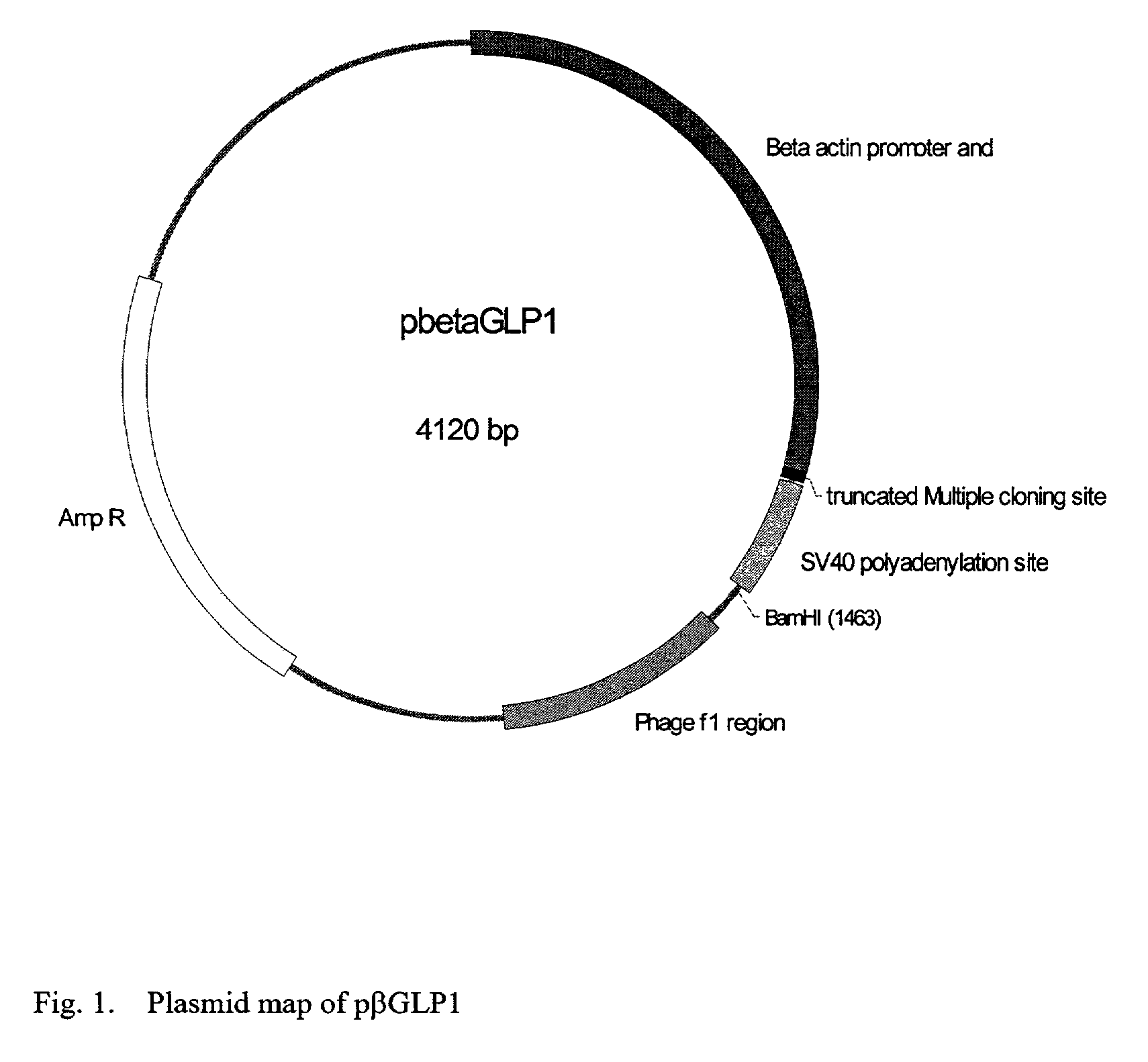GLP-1 gene delivery for the treatment of type 2 diabetes
a type 2 diabetes and glp-1 technology, applied in the direction of genetic material ingredients, hormone peptides, peptide/protein ingredients, etc., can solve the problems of difficult to consistently deliver the active form of glp-1, short plasma half life and metabolic clearance rate, and still no definitive treatment for the disease. , to achieve the effect of rapid clearance of particles, effective penetration into tissue, and easy control
- Summary
- Abstract
- Description
- Claims
- Application Information
AI Technical Summary
Benefits of technology
Problems solved by technology
Method used
Image
Examples
example 1
Construction of Plasmid Vector
[0049]This example illustrates the construction of the plasmid which expresses GLP-1 (FIG. 1.). In this plasmid, GLP-1 expression was driven by chicken β actin promoter and enhancer. GLP-1 (7-37) gene was synthesized using a DNA synthesizer. The start codon encodes methionine. If the N-terminal amino acid of the produced GLP-1 is methionine, it will not be an active form, because the first two amino acids of GLP-1 are the receptor binding domain. A furin recognition site (ArgGlyArgArg: SEQ ID NO: 5 CGTCAACGTCGT) was inserted into the synthesized GLP-1 (7-37) gene just after the start codon. When the produced GLP-1 is secreted from the cell, the methionine is cleaved by the furin in the Golgi apparatus. To replace the promoter part (chicken β actin promoter and CMV promoter),chicken β-actin promoter and enhancer were isolated from pEBActNII by digestion with BglII and XbaI. The pEBActNII was provided by Dr. Kaneda (Osaka University). The CMV promoter of ...
example 2
Synthesis of PAGA and Formation of PAGA / DNA Complex
[0050]This example illustrates the preparation of a gene delivery composition, according to the present invention.
[0051]PAGA was synthesized as previously described in U.S. Pat. No. 6,217,912, hereby incorporated by reference. Briefly, CBZ-L-oxylysine was synthesized from CBZ-L-lysine. CBZ-L-oxylysine was polymerized by a melting condensation reaction at 150° C. under a vacuum of 10−4 Torr for 5 days. The polymer was dissolved with chloroform and precipitated with methanol. The dried polymer was dissolved with DMF containing a palladium activated carbon catalyst. 85% formic acid was added as a proton donor. After 15 hours at room temperature, the polymer solution was isolated from the catalyst by addition of 2 N HCl and the polymer was precipitated with acetone. PAGA was stored at −70° C. until use.
[0052]The DNA / carrier complexes were prepared by self assembly. PEI (25,000 Da) and PAGA were dissolved in PBS (pH 7.3). Ten times dilut...
example 3
Expression of GLP-1 mRNA in Transfected HepG2 Cells
[0054]This example illustrates the expression of GLP-1 mRNA in transfected HepG2 cells. To analyze the expression of the gene, RT-PCR was carried out on the pβGLP1 / PEI complex that was transfected into HepG2 cells used to evaluate the expression of GLP-1
[0055]HepG2 cells were maintained in MEM supplemented with 10% FBS in a 5% CO2 incubator. For the transfection studies, the cells were seeded at a density of 2.25×105 cells / 6 well culture plates and incubated for 24 hours before the addition of the pβGLP1 / PEI complex. The pβGLP1 / PEI complexes were prepared by mixing plasmid and PEI at an N / P ratio of 1:5 (the weight ratio was 1:0.676) in serum free MEM medium and then incubated for 30 minutes at room temperature. The cells were washed twice with PBS, and then 2 mL of fresh serum-free MEM media was added. The pβGLP1 / PEI complex was added to each well. The cells were incubated for 4 hours at 37° C. in a 5% CO2 incubator. After 4 hours,...
PUM
| Property | Measurement | Unit |
|---|---|---|
| particle sizes | aaaaa | aaaaa |
| diameter | aaaaa | aaaaa |
| diameter | aaaaa | aaaaa |
Abstract
Description
Claims
Application Information
 Login to View More
Login to View More - R&D
- Intellectual Property
- Life Sciences
- Materials
- Tech Scout
- Unparalleled Data Quality
- Higher Quality Content
- 60% Fewer Hallucinations
Browse by: Latest US Patents, China's latest patents, Technical Efficacy Thesaurus, Application Domain, Technology Topic, Popular Technical Reports.
© 2025 PatSnap. All rights reserved.Legal|Privacy policy|Modern Slavery Act Transparency Statement|Sitemap|About US| Contact US: help@patsnap.com



